 We are joined by Lisa Cho, a California native who moved to Ecuador two years ago to fulfill a life dream of living abroad. Her favorite hobbies are photography, traveling, writing, snorkeling, and the argentine tango.
We are joined by Lisa Cho, a California native who moved to Ecuador two years ago to fulfill a life dream of living abroad. Her favorite hobbies are photography, traveling, writing, snorkeling, and the argentine tango.
I came to the Galapagos, like many visitors, hoping to see the famous mating rituals – the display of the red-chested frigate bird, the comical dance of blue-footed boobies, and territorial fights between marine iguanas. But I quickly found something more fascinating, perhaps less famous, but exceedingly heart-warming. Among the groups of mating animals, we found some of the most adorable and unique babies, just days or weeks out of the nest. There were fluffy down-covered birds, ironically tiny giant tortoises, and bouncing sea lion pups, all beginning the harsh struggle for survival in different ways.
Playful sea lion pups
On our first day on San Cristobal Island, my first memory is being drawn to the rocky shore where sea lion babies were playing like puppies. We saw them snuggling up to mom, squeaking, and rolling over each other in the sand. Later some of the older ones even came and swam with us in an exhilarating game of chicken. They came barreling towards us, waited until the last second, back-flipped and sped away.
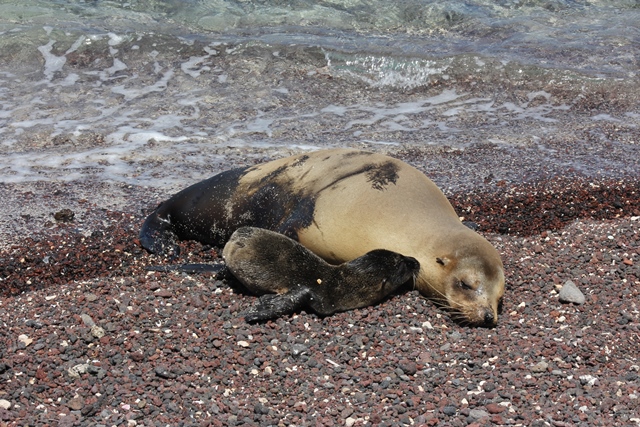
Red footed boobies without red feet
On the north side of the island we spotted odd-looking brown birds, practically camouflaged against the dry landscape, where compacted volcanic ash had formed a dramatic landscape. The fascinating part was how different they looked from the adults down the trail, whose brilliant red feet and pearly blue beaks were unmistakable. I would not have known that we were looking at the same species without our guide. After closer scrutiny, however, I was able to see the family resemblance.
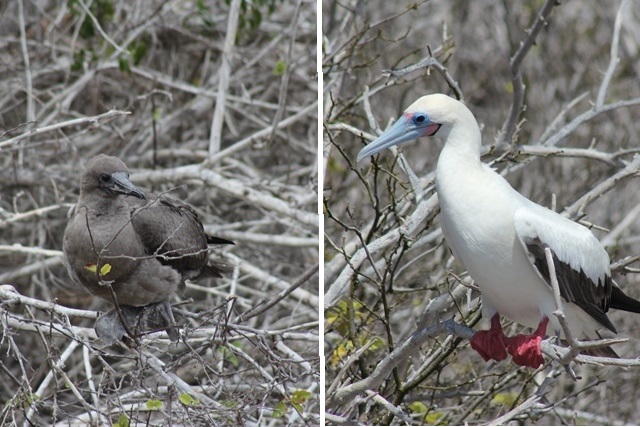
Blue footed boobies too young to fly
We arrived the next day to the bird-lovers paradise of Española Island. This recently-born blue footed booby resembled a cotton ball, white, fluffy, and pint-sized. It tried to walk, stretch its wings, but it quickly fell flat on its face.
Nearby, a slightly older juvenile was walking and stretching its wings, but as our guide pointed out – still relied on mom and dad for its daily meals.
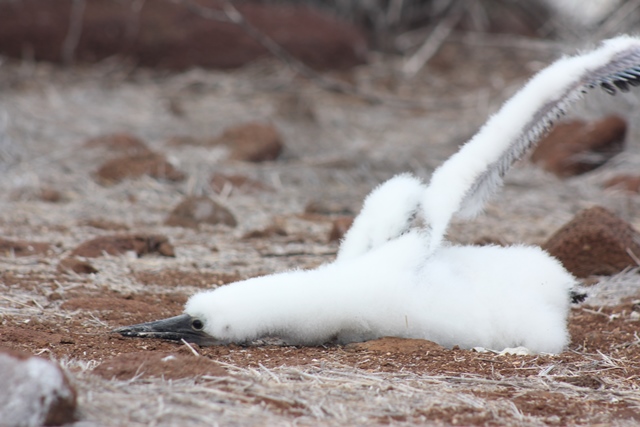
Hungry swallow-tailed gull chicks
Down the trail, hungry down-covered baby swallow-tailed gulls opened their beaks wide and chirped “Feed me!” We watched as some squeaked and squeaked, impatient for mom to get back, but others were lucky enough to get their afternoon snack delivered fresh from the ocean, beak-to-beak.
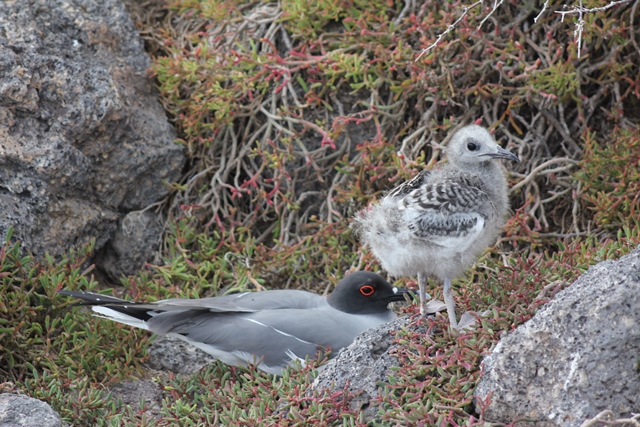
Sibling rivalry among young waved albatross
We soon saw the most famous sight of Española Island, the waved albatross. It is the largest bird in the Galapagos with a wing span up to 8 feet. This meant the chicks were enormous – the size of a human toddler – but still covered in soft brown down. They waddled about, and stood face to face, quabbling over territory, their beaks opening and snapping shut. The conflict did not get too heated though, and the adults did not seem to care as they sat on the other side of the trail, nuzzling beaks.

Giant tortoise babies are anything but
The next day we visited the Charles Darwin research center on Santa Cruz Island, where conservationists breed giant tortoises in captivity to protect the young from invasive species. There was a gradually progression in size from the newborns to the 5-year-olds, and finally to the enormous and possibly 100-year-old adults. The tiny shells of the newly-hatched tortoises measured just inches across. My mind turned in circles thinking about how much they will grow, how long they will live (maybe 150 years?), and all years in between.

Frigate bird chicks are deceptively cute
On North Seymour we learned about the frigate birds, the pirates of the archipelago because they steal food by chasing the smaller birds, and pulling on their wings until they regurgitate. The baby frigate birds looked surprisingly innocent and cute for a creature we knew would later become the biggest bully in the Galapágos sky.

A farewell surprise from the Galapágos
After a week the tour was over and we sadly disembarked the M/V Eric, but before returning home I took time to relax and go to the beach on Santa Cruz Island. Some of the local kids started shouting in excitement, so I took a break from sunbathing to investigate. I could not believe it. There was a baby hammerhead shark just a foot long swimming around the shallows. The kids laughed, giggled, and splashed the water around. The shark swam excitedly in circles and zigzags, like a vicious killer but endearingly harmless. Would it be hard-hearted to say that the shark was cuter?
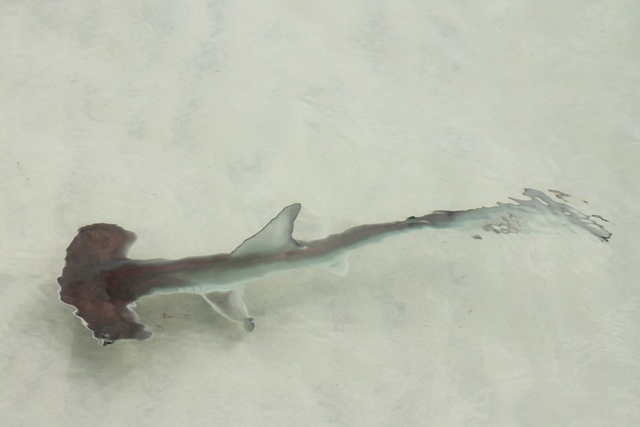
A great sense of amazement and delight came over me. Whether it came from the shark, the baby birds, the baby tortoises, or all the sights of an unforgettable week, I cannot say.




